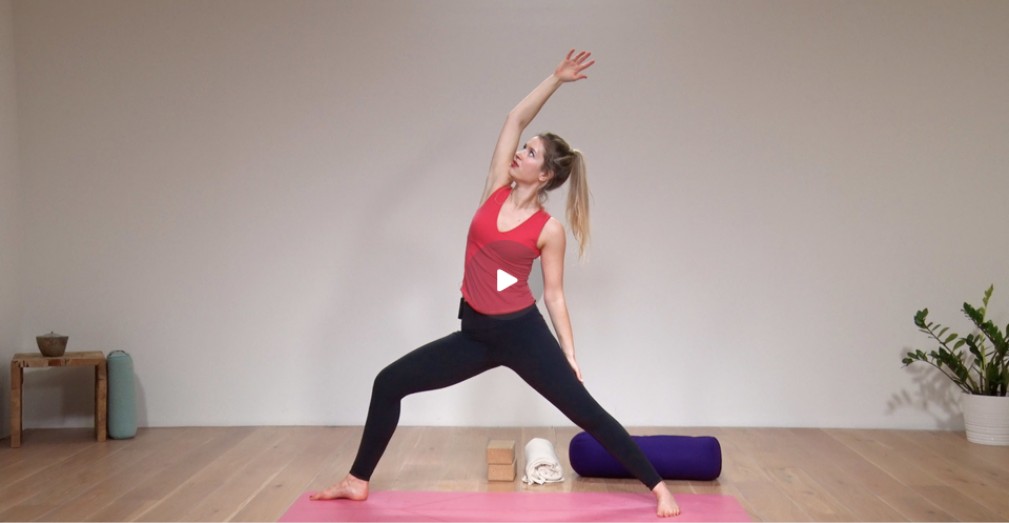The next stop on our journey through the five elements is the air element. With its qualities of lightness, clarity and movement, the air element has been connected to gods, goddesses and deities for thousands of years.
In ancient Greece, the four wind gods governed north, south, east and westerly directions, and were considered to ‘move’ the four seasons through the year. Vayu is the primary Hindu deity of winds and breath, said to have been ‘exceptionally beautiful’, riding through the sky ‘noisily’ on his shining chariot.
As the ancients seem to have known, we may not be able to see air and wind, but they have a profound impact on the world around us, and are an invisible yet powerful force of nature.
Within our own bodies, there are subtle energetic winds – known as the Vayus – that correspond to our physical and emotional actions. Yogic texts say that keeping these winds moving well is one of the keys to caring for ourselves. These movements of air include Udana Vayu: the upward-and-outward movements of speech, singing, exhaling, thinking, and vomiting; Prana Vayu: the movement of subtle life-force energy around the heart and lungs; Samana Vayu: the air energy governing digestion in the centre of the body; Vyana vayu, which pervades the whole body; and Apana Vayu, governing down-and-out energy like the ability to feel connected to the earth, elimination, and menstruation.
For an element that can’t be seen, air certainly holds a vast array of sacred symbolism – such as communication, breath and life. When we consider how the air element interacts with our senses, we can experience this part of nature in a way that helps us become more present and sensitive to the world around us.
Air Element & the Heart Chakra
The air element is directly linked to Anahata (the heart chakra) and the sense of touch. Often thought of as the place where the soul abides, the heart is a place we might consider our life energy to be held. As you’ll have read in the words above, the heart and chest are where Prana Vayu primarily circulates.
Prana has many translations, meaning ‘life force energy’, but also ‘breath’. As is the case with most Sanskrit words, the word ‘breath’ in this sense is far deeper than simply a description of the movement of air in and out of the lungs. Breath refers to the energy behind each inhalation and exhalation we take, the life force behind that breath, and the way the world around us ‘breathes’ too.
One of the most soothing ways I like to remember this, is to place one hand on my heart, and one hand on a tree, or plant. As you inhale, know that you’re inhaling oxygen gifted to you by nature. As you exhale, know that you’re exhaling breath and life back into the plants too.

Practices to tune into the Air Element
Touch: Feel the wind in your hair
One of the methods used in ‘nature therapy’ is to simply tune into the sensations of nature around you. This could be the warmth of the sun on your skin, the earth beneath your feet, or the wind on your skin.
The next time you’re out in nature – or on your balcony, or in your garden! – pause for a moment and tune in: Notice the feeling of the wind on your face or hands. Does it feel cold or warm? Is it gentle or forceful? Which direction is it coming from? These subtle cues are a wonderful way to become present and engaged with your surroundings instantly.
Taste: Bitter and astringent
According to the ancient health system of Ayurveda, each taste made up of a combination of the elements. Air is present in the bitter and astringent tastes. These tastes can help cultivate a sense of lightness, help repair wounds, remove excess swelling or water retention, and ‘dry out’ congestion from phlegm or mucus.
Opt for kale and collard greens, Brussel sprouts, and cacao for the bitter taste. For the astringent, choose and pomegranates, black tea, legumes, and artichokes for the astringent taste. These foods can all help impart a sense of cooling and grounding, so are good to eat in hot and humid weather.
Sight: Watch the world move
We may not be able to see air and wind itself, but we can certainly see how it moves the world around us. From the impossible to miss movements of tornadoes and hurricanes, to the smallest breeze on a Summer’s day – wind and air are the energy behind much of the movement around us.
Step outside and notice how the air is moving plants, leaves and clouds. Do these things move in an erratic and playful way? Is the movement smooth and slow? How do you feel when the weather is windy and blustery outside?
Smell: Fresh air
An invisible yet important factor of feeling well and healthy at home, is the air quality in which we live. When we walk into a room, we’re affected by the colours, shapes and textures around us. But scent also plays a huge role when it comes to our emotions.
Take a moment to breathe in the air in your living room, bedroom or kitchen. Does it smell old and tired? Are there scents of last night’s dinner, or do you simply get a sense that the room needs a little life breathed into it? As often as you can, open the windows and let fresh air circulate around the room. This is especially important in your bedroom, as fresh, cool air can help improve sleep quality too.
Sound – The vibration of sound
Air may not make sound itself, but without it, we wouldn’t be able to hear anything! Air carries the vibration of sound waves, allowing us to hear our favourite song or the voices of our friends. Close your eyes and notice the sounds you can hear. Millions of soundwaves around you – from the hum of the refrigerator, to the meow of your cat – are all being carried by air. When you walk in the park or through a forest, stop to listen to the sound of the wind moving through the trees. Pause and enjoy this completely natural soundscape.
Perhaps it’s moments like these that brought to life the gods, goddesses and deities of the air and winds thousands of years ago, inspiring books, poems and hymns about their powers, connecting us to the elements of nature even more.
Pranayama
Breathing is perhaps the most direct and intimate way we can connect to the air element. Try practicing a few minutes of simple Sama Vritti (equal breathing) before you get out of bed in the morning. This practice involves gently breathing in and out for an even count (try starting with a count of five), and observing the subtle sensations of life force energy moving through your body.
Take the practice a step further by using your observation of the breath as a tool for meditation, similar to Buddhist techniques. Focus on the breath intently, and if your mind wanders, return it back to your point of focus. Start with five minutes and work your way up to twenty minutes of meditation per day, time permitting.
Yoga postures & movements for the air element
Anything that helps open the heart, lungs and front of your body can aid the connection to your breath and the air element. Try gentle backbends like a restorative supported bridge pose, cobra and upward facing dog. Practice yoga sequences that encourage more flowing, light and playful movements. The next time you practice yoga, experiment with focussing on your breathing even more; are there certain postures that facilitate calm, steady breathing? Or do you find yourself holding your breath when approaching a challenging asana?
Heart wide open class with Rose van Ooijen
This practice aims to melt open space in and around your heart, physically, energetically and emotionally. Invite in even more loving energy to one of the most important recipients: you!
Read more of Emma’s series on The Five Elements in Yoga
- Journey through The 5 Elements: Earth
- Journey through The 5 Elements: Water
- Journey through the elements: Fire
- Journey through the 5 Elements: Ether
Main photo courtesy of Mark Kleen on Unsplash


